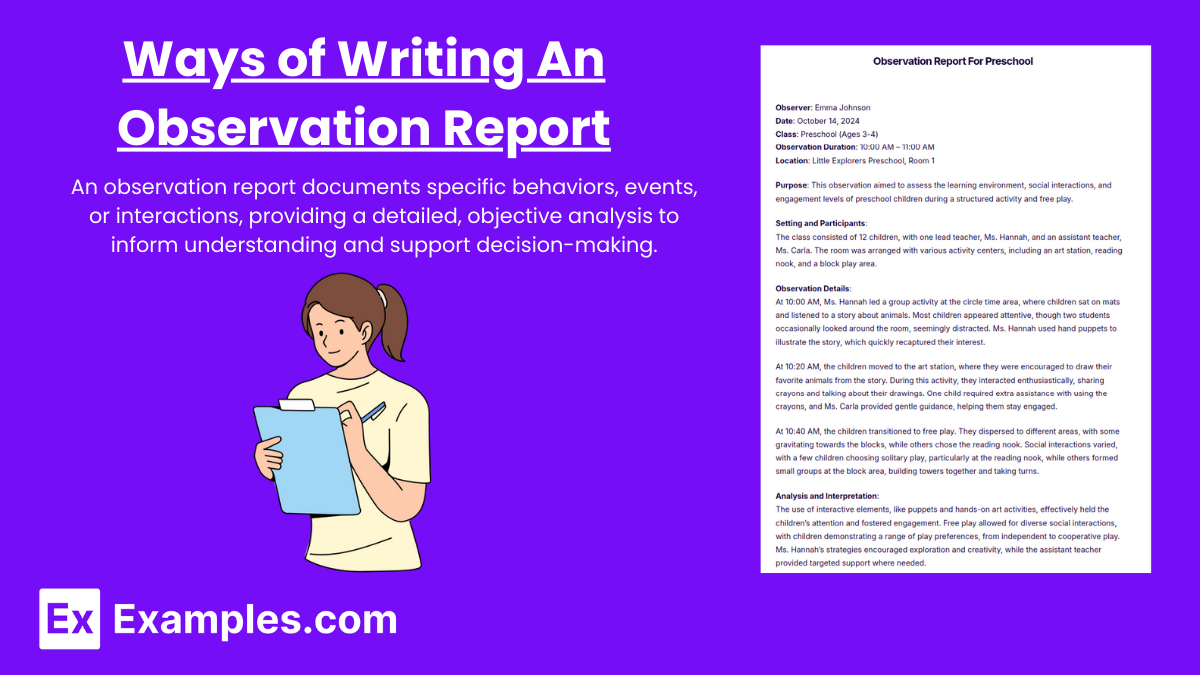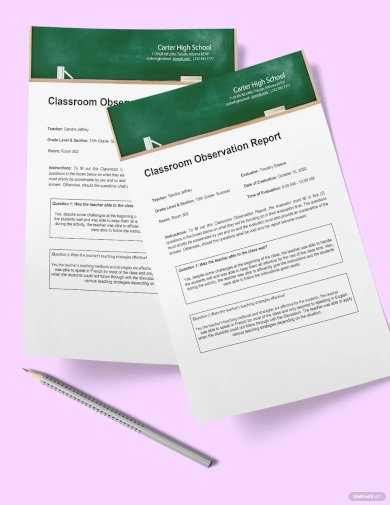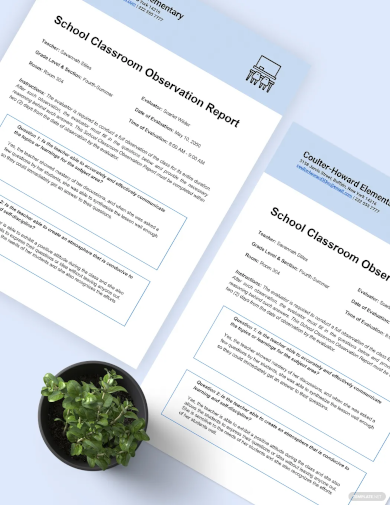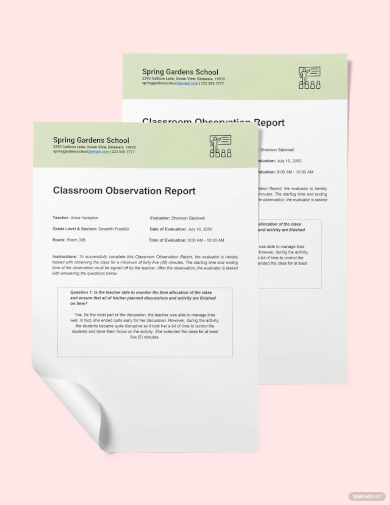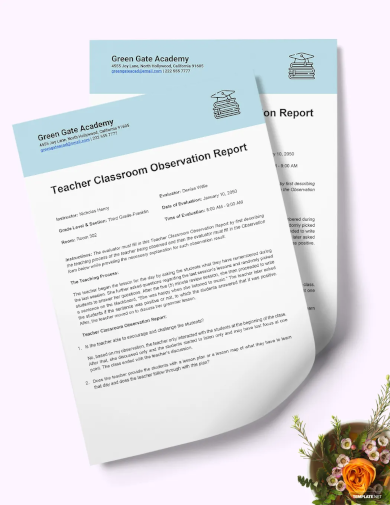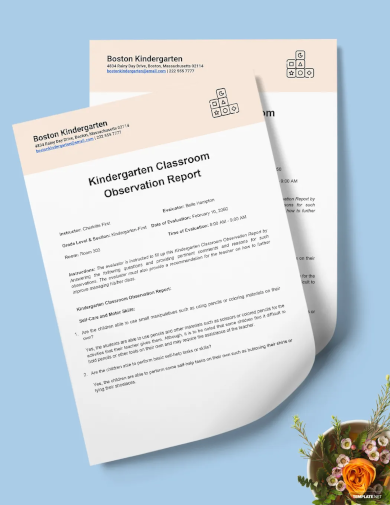Ways of Writing An Observation Report
Your classes may require you to do many reports. One of them is making observation reports. Observation reports can help you hone your skills if you’re planning to be a writer. But what is an observation report? This type of report not only does require you to just observe things, people, or places; it also allows you the opportunity to practice writing and editing about anything you have observed. However, like any other report, there are steps to be followed and if that is followed, will make the task of writing an observation paper much easier and quicker. You may also see project report examples & samples
What is Ways of Writing An Observation Report
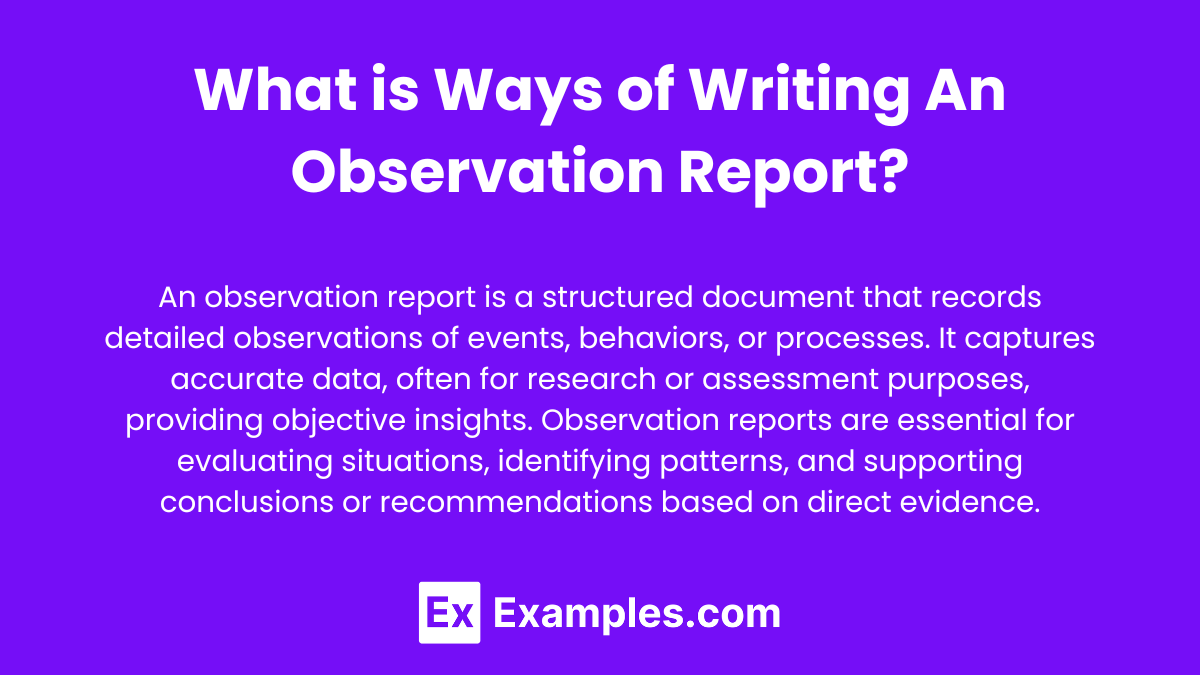
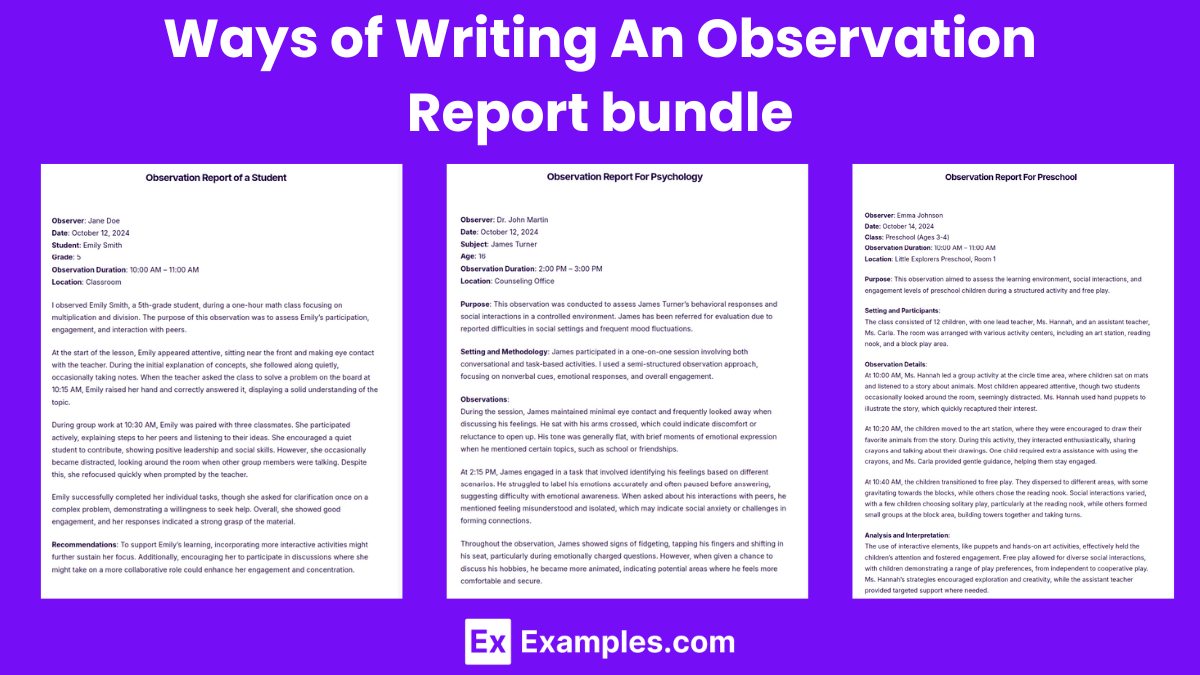
Download Ways of Writing An Observation Report
Ways of Writing An Observation Report Format
Title Page
Include the report title, your name, date, and any relevant details about the setting or organization.
Introduction
- Objective: Briefly state the purpose of the observation.
- Scope: Describe what you are observing, the context, and the reason for choosing this particular subject.
Background Information
- Setting and Participants: Provide a description of the environment, location, and individuals involved.
- Time and Duration: Specify when the observation took place and how long it lasted.
Methodology
- Observation Techniques: Outline the methods used for collecting data (e.g., note-taking, a/video recording).
- Data Collection Approach: Explain whether you used structured, semi-structured, or unstructured observation methods.
Detailed Observations
- Chronological Order: Present the observations in the order they occurred.
- Descriptive Details: Include specific details about actions, behaviors, and interactions.Use of Direct Quotes: When relevant, include exact phrases or words spoken by participants to provide context.
Analysis and Interpretation
- Identify Patterns: Discuss any recurring themes or behaviors observed.
- Relate to Objectives: Link your observations to the original goals and provide explanations.Insights and Implications: Offer any insights gained and discuss potential implications of your findings.
Conclusion
- Summary of Key Findings: Recap the main observations and their significance.
- Recommendations: Suggest any actions, further observations, or changes based on your findings.
Ways of Writing An Observation Report Example
Classroom Observation Report – 3rd Grade Reading Class
October 10, 2024
Greenfield Elementary School, Room 203
Observer: John DoeDear Principal Anderson,
I am writing to provide you with a summary of my recent observation of Ms. Smith’s 3rd-grade reading class. The observation took place on October 10, 2024, from 10:00 AM to 11:00 AM in Room 203. The purpose of this report is to assess the teaching methods and student engagement during the session on reading comprehension.
The class consisted of 25 students seated in rows, with Ms. Smith leading the lesson. The room was well-organized, featuring a reading corner and various educational posters. I utilized a non-participatory observation approach, taking notes discreetly from the back of the room to avoid disrupting the class.
The session began at 10:05 AM when Ms. Smith introduced a short story, immediately engaging the students by asking them to predict the ending. Several students responded eagerly, and she selected volunteers at random, ensuring participation across the class. At 10:15 AM, Ms. Smith prompted students to pair up and discuss their predictions. She circulated among them, occasionally offering prompts to stimulate deeper thinking.
At 10:30 AM, Ms. Smith introduced a worksheet related to the story. She explained the worksheet thoroughly, verifying that students understood each question, and encouraged them to collaborate if needed. By 10:45 AM, she was listing key points from the story on the whiteboard, and students actively contributed, demonstrating a clear understanding of the material.
Throughout the session, I noticed that Ms. Smith consistently used open-ended questions, which appeared effective in promoting critical thinking. Additionally, her use of peer discussions fostered collaborative learning. The overall structure of the lesson, with a blend of individual tasks and group activities, kept students engaged and responsive. Ms. Smith’s methods align well with the objective of encouraging active participation and comprehension among her students.
Based on these observations, I recommend incorporating more visual aids to support visual learners, as this could further enhance engagement. Future observations might explore additional teaching strategies that could vary the delivery and cater to diverse learning styles.
Please let me know if you require further details or if there is anything specific you would like to discuss about this observation.
Sincerely,
John Doe
Short Ways of Writing An Observation Report Example
Title: Observation Report on Workplace Meeting
Observer: Sarah Lee
Date: October 12, 2024
Location: Company Conference RoomI observed a one-hour team meeting led by the project manager, Mr. Adams, with eight team members. The purpose of the observation was to assess team dynamics and communication styles. The meeting began at 9:00 AM with Mr. Adams reviewing the project timeline. He used a PowerPoint presentation to outline key tasks, and team members appeared attentive.
At 9:15 AM, Mr. Adams invited input on the timeline. Most team members shared updates on their tasks, but two remained silent, suggesting possible disengagement. Mr. Adams encouraged participation by asking specific questions, which helped increase engagement. At 9:45 AM, the meeting shifted to brainstorming, with team members suggesting improvements for upcoming phases.
In conclusion, Mr. Adams displayed effective leadership by facilitating open discussion and using targeted questions to engage quieter members. For future meetings, incorporating interactive tools like polls could further encourage participation from all team members.
Observation Report of a Student
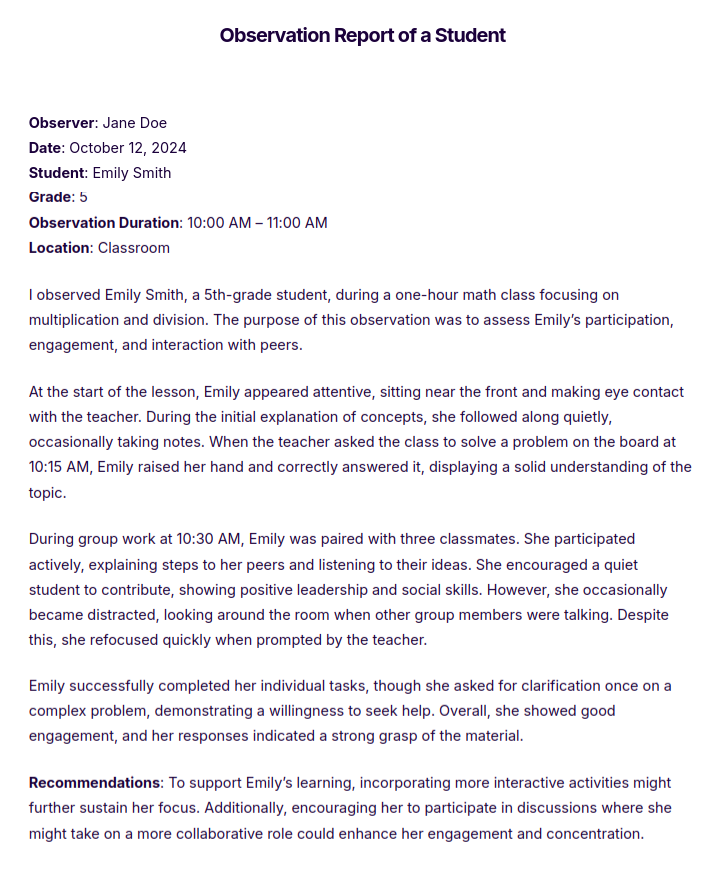
Observation Report For Psychology
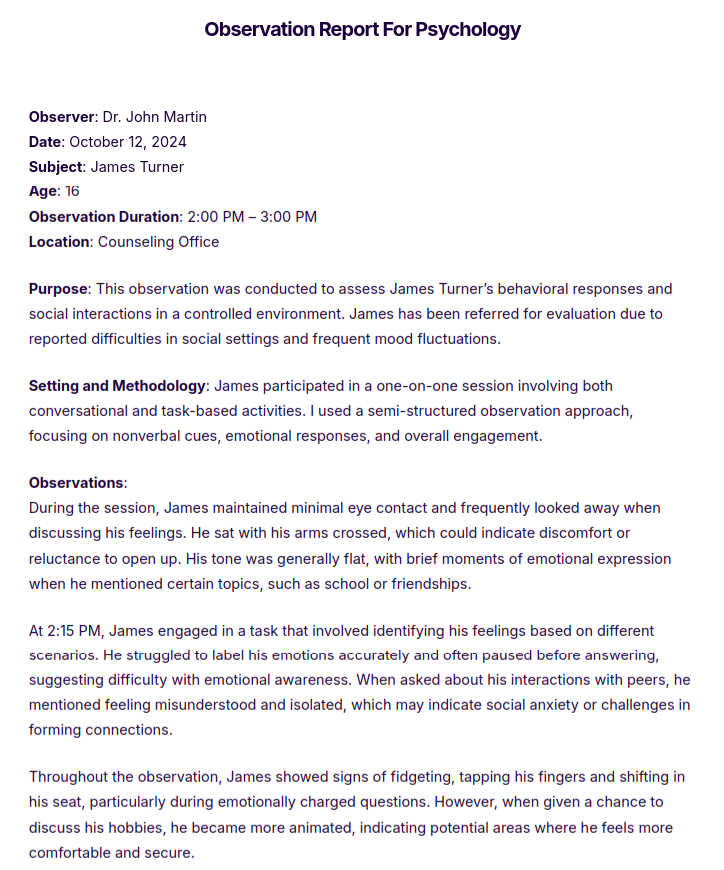
4+ Observation Report Examples
Classroom Observation Report Template
School Classroom Observation Report Template
Sample Classroom Observation Report Template
Teacher Classroom Observation Report Template
Kindergarten Classroom Observation Report Template
How to Write a Ways of Writing An Observation Report?
1. Understand the Purpose of the Observation
- Define Your Objective: Identify why you are observing and what you aim to learn or achieve. Are you focusing on behaviors, interactions, performance, or environmental factors? Clarifying this will guide your focus during the observation.
- Know the Scope: Determine what you will observe (such as specific actions, interactions, or processes) and how you will document them.
2. Plan the Observation
- Select a Methodology: Choose between structured (specific behaviors), semi-structured (open-ended with a focus), or unstructured (free-form) observation. Each method suits different types of observations and reporting needs.
- Prepare Observation Tools: Use note-taking, checklists, or a/video recordings, depending on what is allowed and suitable for the environment.
3. Conduct the Observation
- Be Objective: Record what you see without interpreting or assuming motivations. Focus on facts—actions, words, and direct interactions.
- Take Detailed Notes: Note relevant details such as time, setting, participants, and specific behaviors. For accuracy, document events as they occur, or immediately afterward.
4. Organize Your Findings
- Structure Your Report: Use a format that includes an introduction, observation details, analysis, and conclusion. This helps present information clearly and logically.
- Describe the Setting: Begin with a description of the environment and participants, setting the context for your observations.
- List Observations in Chronological or Thematic Order: Present observations in the order they occurred or by themes, such as behaviors, interactions, or activities.
5. Analyze and Interpret the Data
- Identify Patterns or Themes: Look for recurring behaviors or interactions. Describe how these relate to the objective and what they might imply.
- Draw Conclusions: Based on your analysis, summarize key findings and explain their significance. Relate them back to the purpose of the observation.
6. Make Recommendations (if applicable)
- Suggest Actions: If your report is for developmental or evaluative purposes, include recommendations based on your findings. These might involve strategies for improvement, further observations, or interventions.
7. Write and Review the Report
- Use Clear, Objective Language: Avoid subjective language and focus on factual descriptions. Be concise but thorough.
- Edit and Proofread: Ensure accuracy, clarity, and coherence. Check for any biases and remove unnecessary details.
Importance of Writing an Observation Report
1. Enhances Understanding and Learning
- Detailed Documentation: An observation report captures specific details about an event or behavior, which helps deepen understanding. This can be particularly valuable in educational settings, where teachers use observations to tailor instruction based on student needs.
- Supports Reflection: Writing a report encourages reflective thinking, helping observers to assess their own biases and gain a more objective understanding of what occurred.
2. Facilitates Data-Driven Decisions
- Informs Strategies and Interventions: Observation reports provide factual information that can be used to make informed decisions. For example, teachers can use reports to identify students who may need additional support, or managers can use them to improve workplace procedures.
- Tracks Progress and Patterns: Regular observations over time can reveal trends or patterns that might not be immediately obvious. This data can inform future strategies and interventions to improve outcomes.
3. Supports Communication and Accountability
- Clear Communication: An observation report provides a structured and objective way to communicate findings to others, such as parents, colleagues, or stakeholders. This ensures that everyone has a shared understanding of the situation.
- Ensures Accountability: Documenting observations helps create a record that can be referred back to when assessing the effectiveness of interventions or decisions. This accountability is crucial in fields like healthcare, education, and social work.
4. Promotes Objectivity and Reduces Bias
- Objective Recording: Writing an observation report requires focusing on factual descriptions, which helps minimize personal biases. This objectivity is especially important in research and evaluation contexts.
- Standardizes Evaluation: By following a consistent format, observation reports provide a standardized way to evaluate and compare different cases or individuals, ensuring fairness and consistency.
5. Supports Professional Development
- Skill Development: The process of observing, documenting, and analyzing enhances skills such as attention to detail, critical thinking, and analytical abilities. These skills are valuable in a wide range of professional contexts.
- Facilitates Feedback and Improvement: Observation reports often form the basis for constructive feedback, allowing individuals or teams to learn and improve over time.
6. Contributes to Research and Knowledge Building
- Informs Research Findings: Observation reports are commonly used in qualitative research to provide insights into human behavior, organizational dynamics, or social interactions. They contribute valuable data that supports the development of theories and practices.
- Creates a Knowledge Base: Documented observations add to the existing body of knowledge in a field, enabling others to build on previous work and contribute to continuous improvement.
FAQs
1. What is an observation report?
An observation report is a document that records detailed observations about specific behaviors, events, or settings. It is often used in educational, professional, or research contexts to provide objective information that can support analysis, decision-making, or interventions.
2. What should be included in an observation report?
An observation report typically includes the purpose of the observation, details about the setting and participants, a description of the observed behaviors or events, an analysis of the findings, and any conclusions or recommendations. It should be structured to clearly communicate all relevant details.
3. How do I ensure objectivity in an observation report?
To maintain objectivity, focus on factual descriptions and avoid making assumptions or judgments. Record what you see and hear without interpreting motivations. Using a structured format and reviewing the report for any potential biases can also help ensure objectivity.
4. What are the different types of observation methods?
Common observation methods include structured observations (focused on specific behaviors or criteria), semi-structured observations (combining specific focus areas with open-ended observation), and unstructured observations (open-ended and free-form). The choice of method depends on the purpose of the observation.
5. Why is writing an observation report important?
Writing an observation report is important for documenting accurate information, identifying patterns, supporting data-driven decisions, and communicating findings to others. It also fosters reflection, accountability, and professional development by improving skills like attention to detail and critical analysis


